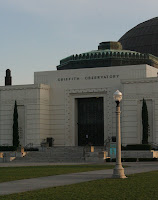“When I walk down the street people say ‘Mama, Mama,’” said Sandra Romero, owner and operator of Mama’s Hot Tamales in Los Angeles.
“I love L.A.,” Romero said. “I enjoy helping people and seeing them grow and achieve. I forget about me.”
Romero’s restaurant, which is located near MacArthur Park, started off as a project with the city of Los Angeles. The non-profit was set up with the Institute for Urban Research and Development to help organize the street vendors that are common throughout the city.
 The area just past the entrance is often filled with tables that local artisans can use to display their artwork, crafts and jewelry.
The area just past the entrance is often filled with tables that local artisans can use to display their artwork, crafts and jewelry.Romero and her business partner applied and got a contract to start the project and she said they had no idea that it would turn into a restaurant.
“We started designing carts,” Romero said. “We designed them to be attractive.”
The first carts designed to sell food were put out in 1999. At first they did not have permits to sell hot foods, but when they did, they began selling tamales.
Romero said there were a total of eight carts. Each cart had a different style of tamale. One cart contained “Mexico” tamales and another contained “Peru” tamales and the rest were named for the country of origin.
 Tamales have not only helped street vendors, but they have become a way to help revitalize the MacArthur Park area.
Tamales have not only helped street vendors, but they have become a way to help revitalize the MacArthur Park area.Throughout the process of selling tamales, Romero was not in it for the profits. The goal of the program was to take the vendors off the streets and teach them how to prepare the food to code and how to obtain all of the necessary permits that they needed to be street vendors in Los Angeles.
“One hundred percent of the proceeds was theirs,” Romero said. “We provided the kitchen and a place to store the carts.”
“It’s the miracle kitchen,” Romero added.
In about 2002 Romero wanted to help the vendors make more money and she got the permits needed to open the restaurant.
 Mama's Hot Tamales is full of vibrant colors and designs, from the walls to the chairs and tables. No area in the restaurant has been left bland or boring.
Mama's Hot Tamales is full of vibrant colors and designs, from the walls to the chairs and tables. No area in the restaurant has been left bland or boring. “My business partner called me one night and said, ‘we’re going to call it Mama’s Hot Tamales,’ and he said ‘you’re going to be Mama,’” Romero said. “He anointed me Mama.”
“She has worked so hard to make this program work,” Ilecara Velez, a volunteer at the restaurant said.
 Velez has been volunteering at the restaurant for about a month. Her mother has been working in the kitchen for close to three months.
Velez has been volunteering at the restaurant for about a month. Her mother has been working in the kitchen for close to three months.“It helps people start their own business and get on the right track,” Velez said. “I like to help because we’re doing it for the right cause.”
Nickole Debronsky and her business partner are vendors who have received help from Romero.
“I want to sell at the farmer’s markets,” Debronsky said. “We came and she sat down with us and told us what we needed and we really liked what she was doing.”
Debronsky has just started volunteering at the restaurant as a way to give back.
“She helps a lot of people,” Debronsky added. “I figured why not give back to her.”
Not only is Romero concerned about helping vendors, she is concerned with how the community is doing as a whole. Romero, whose restaurant is located in the Westlake District across the street from MacArthur Park, is also involved in a campaign called Rediscover MacArthur Park and the MacArthur Park Neighborhood Alliance, and has worked hard to impact change in the once crime-filled area.
“The community are my kids,” Romero said.
Mama’s Hot Tamales Café is more than just a restaurant. It is a place to go to enjoy food and to be a part of something bigger.
“Mama’s Hot Tamales Café is designed to provide a valuable experience to our program participants in cooking and serving fresh food to the public. As a patron of the restaurant you are an important part of the educational process,” the restaurant menu said.
 Fresh tamales are not the only items that impress. Fresh strawberry juice, fresh tortilla soup topped with plenty of cheese, tomatoes and cilantro are also delicious.
Fresh tamales are not the only items that impress. Fresh strawberry juice, fresh tortilla soup topped with plenty of cheese, tomatoes and cilantro are also delicious.Expenses
Gas: About $3
Parking (all day lot): $6
Lunch: About $8
Total amount spent: About $17











